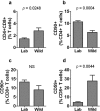Lymphocyte phenotypes in wild-caught rats suggest potential mechanisms underlying increased immune sensitivity in post-industrial environments
- PMID: 22327212
- PMCID: PMC3719982
- DOI: 10.1038/cmi.2011.61
Lymphocyte phenotypes in wild-caught rats suggest potential mechanisms underlying increased immune sensitivity in post-industrial environments
Abstract
The immune systems of wild rats and of laboratory rats can been utilized as models of the human immune system in pre-industrial and post-industrial societies, respectively. In this study, lymphocyte phenotypes in wild rats were broadly characterized, and the results were compared to those obtained by us and by others using cells derived from various strains of laboratory rats. Although not expected, the production of regulatory T cells was not apparently different in wild rats compared to laboratory rats. On the other hand, differences in expression of markers involved in complement regulation, adhesion, signaling and maturation suggest increased complement regulation and decreased sensitivity in wild-caught rats compared to laboratory rats, and point toward complex differences between the maturation of T cells. The results potentially lend insight into the pathogenesis of post-industrial epidemics of allergy and autoimmune disease.
Figures







References
-
- Worldwide variation in prevalence of symptoms of asthma. allergic rhinoconjunctivitis. atopic eczema: ISAAC The International Study of Asthma and Allergies in Childhood (ISAAC) Steering Committee.[see comment] Lancet. 2005;351:1225–1232. - PubMed
-
- Onkamo P, Vaananen S, Karvonen M, Tuomilehto J. Worldwide increase in incidence of Type I diabetes—the analysis of the data on published incidence trends. Diabetologia. 1999;42:1395–1403. - PubMed
-
- Black P. Why is the prevalence of allergy and autoimmunity increasing. Trends Immunol. 2001;22:354–355. - PubMed
-
- Gergen PJ, Turkeltaub PC, Kovar MG. The prevalence of allergic skin test reactivity to eight common aeroallergens in the U.S. population: results from the second National Health and Nutrition Examination Survey. J Allergy Clin Immunol. 1987;80:669–679. - PubMed
Publication types
MeSH terms
Grants and funding
LinkOut - more resources
Full Text Sources

